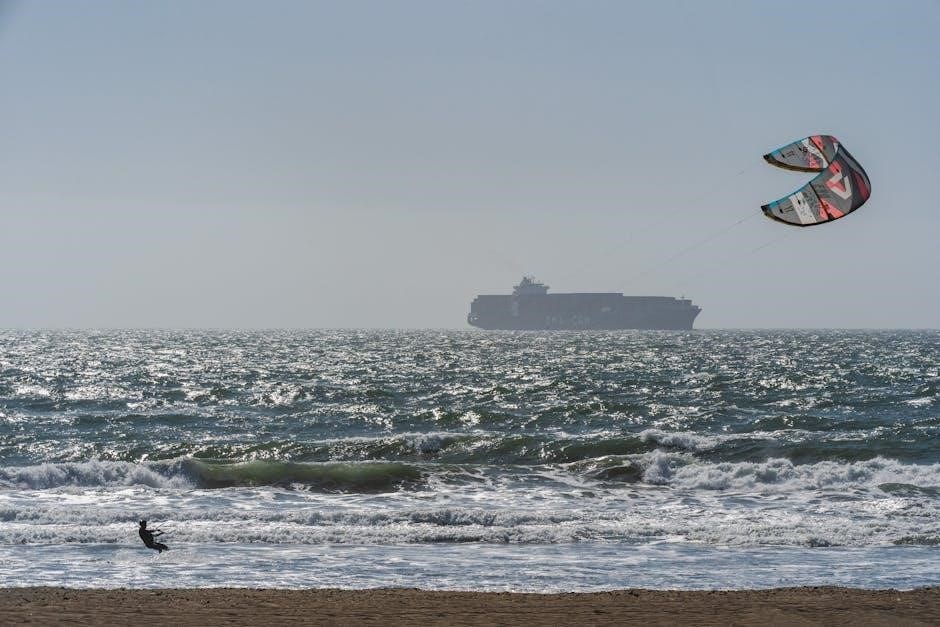The Navy emphasizes motorcycle safety through structured training programs, ensuring riders adhere to strict safety protocols and regulations. This article outlines the essential aspects of Navy motorcycle instruction, including enrollment, safety gear, and training curriculum, to promote responsible and skilled riding practices within the military community.
1.1 Overview of Motorcycle Safety in the Navy
The Navy prioritizes motorcycle safety through mandatory training and strict adherence to safety protocols, reflecting its commitment to reducing accidents and enhancing rider responsibility. Riders must enroll in MSF-certified courses via ESAMS, ensuring they meet rigorous standards. This structured approach promotes a culture of safety, minimizing risks and fostering responsible riding practices among military personnel.
1.2 Importance of Proper Training
Proper motorcycle training is crucial for Navy personnel to ensure safe and responsible riding practices. The Navy mandates MSF-approved courses, such as the Basic Rider Course, to equip riders with essential skills. These programs cover motorcycle controls, basic maneuvers, and street strategies, significantly reducing accident risks. Continuous training reinforces these skills, fostering a culture of safety and accountability among military riders, ultimately protecting both the individual and the community.

Enrollment and Registration Process
Navy personnel can enroll in motorcycle training through ESAMS, which streamlines the registration process for Traffic Safety Classes, including MSF-Motorcycle courses, ensuring compliance with safety standards.
2.1 How to Enroll in Navy Motorcycle Training
Enrollment in Navy motorcycle training is facilitated through the ESAMS system, allowing sailors to view and register for Traffic Safety Classes conveniently. Personnel can access the platform to select courses, such as the MSF-Motorcycle Safety Foundation course, ensuring they meet all training requirements. This streamlined process ensures that sailors can efficiently enroll in necessary training programs to enhance their riding skills and safety knowledge.
2.2 Role of ESAMS in Training Enrollment
ESAMS, the Enterprise Safety Application Management System, serves as a centralized platform for enrolling in Navy motorcycle training. It allows sailors to view available Traffic Safety Classes, such as MSF-Motorcycle Safety Foundation courses, and securely register online. ESAMS streamlines the enrollment process, ensuring efficient course management and compliance with safety training requirements. This system is essential for tracking and verifying completion of mandatory motorcycle safety training, making it a critical tool for Navy personnel seeking to enhance their riding skills and safety knowledge.

Motorcycle Safety Protocols and Gear
The Navy enforces strict safety protocols, requiring essential gear like helmets, gloves, and reflective vests. Adherence to these standards minimizes risks and ensures rider safety during operations.
3.1 Essential Safety Gear for Navy Riders
Navy riders are required to wear Department of Defense-approved helmets, face shields, gloves, sturdy boots, and durable jackets. Reflective vests enhance visibility, while padded gear provides impact protection. Compliance with these standards is mandatory to minimize injury risks and ensure operational safety. Proper gear maintenance is also emphasized to uphold its protective qualities. These measures reflect the Navy’s commitment to rider safety and accident prevention through adherence to established protocols and guidelines.
3.2 Pre-Ride Checks and Maintenance
Pre-ride checks are critical for ensuring motorcycle safety. Riders must inspect tires, brakes, lights, and fluids before operation. Control systems, such as brakes and accelerators, should be tested. Regular maintenance, including oil changes and chain lubrication, is essential to prevent mechanical failures. These practices help identify potential issues early, reducing accident risks. The Navy emphasizes consistent upkeep to maintain roadworthiness and adherence to safety protocols, ensuring riders operate vehicles safely and responsibly.

Training Curriculum
The Navy offers a structured training curriculum with two levels: Level I (Basic Rider Course) and Level II (Advanced Rider Course). These courses focus on building foundational riding skills, safety practices, and advanced techniques, ensuring riders are well-prepared for both on-base and off-base environments.
4.1 Level I: Basic Rider Course (BRC)
The Basic Rider Course (BRC) is a 16-hour MSF-approved program designed for new riders. It covers motorcycle controls, basic riding techniques, balance, and street skills. Participants learn essential safety practices, including pre-ride checks and hazard awareness. The course combines classroom instruction with hands-on training, emphasizing practical skills to build confidence and competence. Completion satisfies Navy training requirements and is mandatory for all military personnel seeking to operate motorcycles.
4.2 Level II: Advanced Rider Course
The Advanced Rider Course (ARC) builds on the foundational skills from Level I, focusing on refining techniques, enhancing decision-making, and improving overall riding proficiency. This course emphasizes advanced braking, cornering, and collision avoidance strategies. Riders learn how to handle complex traffic scenarios and adapt to varying road conditions. The ARC is recommended for experienced riders seeking to elevate their safety and control, ensuring they meet the Navy’s high standards for motorcycle operation and safety.
Post-Training Requirements
After completing Navy motorcycle training, riders must meet ongoing obligations, including periodic refresher courses and maintaining valid certifications. These requirements ensure sustained safety and compliance standards.
5.1 Refresher Courses and Continuous Training
Continuous training is vital for Navy motorcycle riders. Refresher courses, often conducted through MSF-approved programs, help maintain and improve riding skills. These courses cover advanced techniques, safety protocols, and updates on regulations. Riders are encouraged to enroll periodically to stay proficient and adapt to new safety standards. This ongoing education ensures that military personnel remain safe and responsible on the road, reducing accident risks and promoting a culture of safety within the Navy.
5.2 Motorcycle License Requirements for Military Personnel
Military personnel must meet specific motorcycle license requirements, which vary by state and military branch. Completing a Navy-approved motorcycle safety course, such as the MSF Basic Rider Course, often satisfies licensing requirements. Some states allow military members to waive certain tests after completing these courses. However, personnel should verify their state’s specific regulations. Ensuring compliance with licensing standards is essential for legal and safe operation of motorcycles while serving in the Navy.
Safety Data and Accident Prevention
The Navy analyzes safety data to identify trends and prevent motorcycle accidents. Regular training and adherence to safety protocols significantly reduce accident rates among military personnel.
6.1 Statistics on Motorcycle Accidents in the Military
Historical data reveals a concerning trend of motorcycle accidents among military personnel. However, the Navy’s emphasis on safety training has led to a 30% reduction in accident rates over the past decade. Most accidents involve speeding or reckless driving, with a higher incidence among younger riders. The majority of fatal accidents occur off-base, highlighting the need for consistent safety practices. These statistics underscore the importance of rigorous training and adherence to safety protocols to protect military riders;
6.2 Strategies to Reduce Accident Rates
The Navy employs multiple strategies to reduce motorcycle accidents, including mandatory safety training, regular vehicle inspections, and strict adherence to safety protocols. Riders are encouraged to complete refresher courses to maintain skills. Additionally, mentorship programs pair experienced riders with newcomers to promote best practices. Emphasizing defensive driving and situational awareness is crucial. Strict enforcement of safety standards, such as wearing proper gear and following traffic laws, further mitigates risks. These proactive measures contribute significantly to lowering accident rates within the military community.

Incentives for Completing Training
Completing Navy motorcycle training offers certification, recognition, and enhanced privileges, fostering a culture of safety and skill among military riders, encouraging responsible and informed riding practices always.
7.1 Benefits of Completing Navy Motorcycle Safety Courses
Completing Navy motorcycle safety courses offers numerous benefits, including certification, recognition, and enhanced riding skills. Riders gain improved safety awareness, reducing accident risks. Additionally, certification may lead to insurance discounts and increased confidence on the road. The training also fosters a culture of responsibility and adherence to safety protocols, which are crucial for military personnel. By completing these courses, riders demonstrate their commitment to safety, contributing to the Navy’s goal of minimizing motorcycle-related incidents and promoting a safer riding community.
The Navy’s motorcycle instruction program is comprehensive, focusing on safety protocols, rider education, and responsible practices. It ensures military personnel are well-trained, reducing accidents and promoting a culture of safety.
8.1 Summary of Key Points
The Navy’s motorcycle instruction program emphasizes safety, proper training, and adherence to protocols. It includes enrollment through ESAMS, mandatory safety gear, pre-ride checks, and a structured curriculum with Basic Rider Courses. Continuous training and refreshers are required to maintain proficiency. Completing these courses reduces accident risks and ensures riders operate safely, aligning with the Navy’s commitment to protecting its personnel. This approach fosters a culture of responsibility and vigilance, essential for military motorcycle operations.

FAQs About Navy Motorcycle Instruction
Frequently Asked Questions About Navy Motorcycle Instruction provides answers to common inquiries regarding training requirements, safety protocols, and course enrollment, helping riders understand program expectations clearly.
9.1 Common Questions and Answers
Common questions about Navy motorcycle instruction include inquiries about enrollment processes, required safety gear, and training levels. Riders often ask about ESAMS registration, course durations, and the importance of completing refresher courses. Additionally, many seek clarification on motorcycle license requirements for military personnel and how to maintain compliance with Navy safety standards. These FAQs provide clear, concise answers to help riders navigate the training process effectively and safely. Proper preparation and adherence to guidelines are consistently emphasized in the responses.

Further Reading and Resources
For additional information, visit official Navy portals, ESAMS, and MSF websites. Navy Federal also offers guides and resources on motorcycle safety and training requirements.
10.1 Recommended Resources for Additional Information
For further insights, explore the official Navy motorcycle safety website, ESAMS portal, and MSF resources. Navy Federal Credit Union also offers detailed guides. Additionally, review the Motorcycle Safety Foundation Handbook and Navy Traffic Safety Program Manual for comprehensive coverage of training and safety protocols.
Final Thoughts on Navy Motorcycle Safety
Motorcycle safety is a top priority in the Navy, requiring continuous learning and adherence to strict protocols to ensure responsible riding practices and accident reduction.
11.1 The Importance of Ongoing Safety Practices
Ongoing safety practices are crucial for Navy motorcycle riders, emphasizing continuous learning and adherence to updated protocols. Regular refresher courses and maintenance checks ensure riders stay proficient and aware of potential risks. By prioritizing safety, the Navy fosters a culture of responsibility and accident prevention, ultimately protecting both riders and the community. These practices are essential for maintaining high standards of motorcycle safety within the military.
References and Citations
References include official Navy safety guidelines, MSF courses, and ESAMS enrollment resources, ensuring accurate and up-to-date information on motorcycle instruction and safety protocols.
12.1 Sources Used in This Article
The information provided is based on official Navy safety guidelines, Motorcycle Safety Foundation (MSF) course materials, and ESAMS enrollment resources. Additional references include military safety protocols, training manuals, and statistics from credible defense publications. These sources ensure the accuracy and relevance of the content, offering a comprehensive understanding of Navy motorcycle instruction and safety practices.
